Songs and spices: the tastes of Zanzibar
Roving Reporter
03 October 2012, 9:08 AM | Source: Karen Ashford, SBS
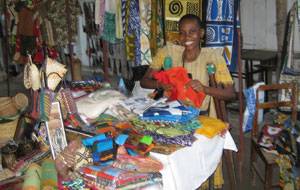
Songs and spices: the tastes of Zanzibar
But first I have to share with you an unexpected delight late yesterday.
A visit to Dar es Salaam’s Village Museum “Kijiji Cha Makumbusho” was a fascinating insight into the lives and homes of 22 different groups from across Tanzania. From cow dung daubed bomas to mud brick cottages with thatched roofs, the museum captures traditions fast being lost to modern bricks and corrugated iron. But as ever in this gorgeous country, it was the people who really shone. The museum hosts a small selection of local artisans – painters, beaders, a tailor, carvers - each proffering the wares at modest prices.
A 17-year-old girl told me of how they’re fighting a constant battle against Asian visitors who come and simply take photos in order to copy their cultural artefacts and undercut the local market. She and her widowed mother are struggling to compete with cheaper fake items and fears it’s eroding the country’s cultural heritage. Across the way, a woman with a disability was sewing the most exquisite aprons made from “khangas”, the sarong-like patterned fabrics that carry messages along their borders. Others were making delicate objects of wire and tiny beads barely a millimetre across, their nimble fingers and needle-nosed pliers fashioning colourful baskets, jewellery and elephant keyrings. And for the grand finale?
A cultural dance and singing with the women really getting into the spirit of things, with Swahili giving way to that most traditional of Australian calls, Aussie Aussie Aussie, oi oi oi!! And there’s only one way to dance to that…
VIDEO: Tanzanian performers get into the Australian spirit!
VIDEO: Tanzanian performers get into the Australian spirit!
But now, onwards to Zanzibar! The island’s palm fringed beaches and aquamarine waters clearly make it a popular destination, even at 10am couples were wandering the white sands and setting off on a day’s adventure on little twin hulled wooden vessels. The island is apparently hugely popular with Italians – nearly 60,000 of them visited last year alone. Makes me wonder why so few Australians have discovered this gem, and obviously the government here is having similar thoughts, looking to market Zanzibar as the Bali of Africa.
But there’s plenty more to Zanzibar than its beaches, as I’m about to discover. We head inland, to farms famed for their spices. And they’re nothing like I expect. In Australia farms are usually pretty regimented, with a particular crop grown here, and another crop grown there, be it a small scale market garden or a large scale pastoral concern. But farms here are a tropical tangle of intermingled species, as if someone has laid claim to a patch of undergrowth and begun harvesting the goodies. Except of course, it has been carefully planted and developed.
The wildness is essential to creating conditions close to the natural environment for these plants, so that the insect that pollinates one can lay its eggs on another, this one gives shade to that, the leaf mulch from here provides nutrients there, and so on. Permaculture before the term was invested. I was guided along meandering paths to see, smell and taste these treats in all their naked glory – green cardamom pods fleshily drooping from their stems, vanilla vines that require hand pollination on the same day that flowers unfurl otherwise no pods will form, a cinnamon tree that isn’t valued just for the bark that’s found on our supermarket shelves, but also for its leaves and roots. And cloves! The pungent king of spices, essential to Zanzibari cuisine. I was in foodie heaven!
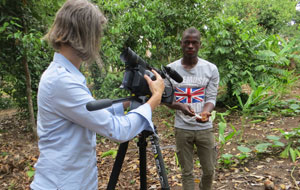
(Mister Butterfly showing off fresh ginger root. His face is adorned with a tangerine coloured substance found around the seeds of a plant aptly called “lipstick”.
Nasim, known as Spice Boy, was putting me through my paces, plucking a leaf of this or fruit of that and challenging me to identify it from its scent. At 5 points a pop, I ended up with about 40 points, shamefully failing to identify unripe pepper as I mistakenly thought that peppercorns grew on a tree instead of a vine, but redeeming my pride by correctly identifying ylang ylang, an inconspicuous bloom with an enchanting scent. Then a visual treat: a demonstration of coconut harvesting.
The East African Tall is an icon of the palm world, its slender truck rising some 20 or so metres skywards to a lush dark canopy bulging with coconuts that yield the sweetest of juice and creamiest of flesh. It is a central ingredient in traditional Zanzibari cuisine; inferior hybrid coconuts just don’t have the same flavour. And whilst the long lived East African palms can produce for generations and be a valuable inheritance, the hybrids exhaust themselves after a few years. Yet this amazing cultural and culinary asset is at risk of being lost to logging for furniture or land clearing for development.
Step forward Mister Butterfly. With the aid of a sisal loop between his feet he shimmies up the trunk in a matter of seconds and pauses halfway to sing! What a voice. I felt fortunate that the Italians hadn’t swept him away to Milan to star at La Scala! All too soon he was back on the ground, deftly slicing the cap off a coconut so we could sip the sweet, slightly spritzig juice within. So mesmerised was I by Butterfly’s performance I hadn’t notice that Spice boy and friends has been busy too, weaving a palm frond necklace shaped like a frog, and a crown festooned with hibiscus blossoms.
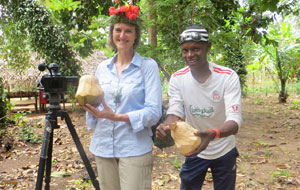
(Queen of spices with frog, crown and coconut? I wore this array for an on-camera appearance, but did another version without them, lest the powers-that-be regard my ensemble as too distracting for a news report!)
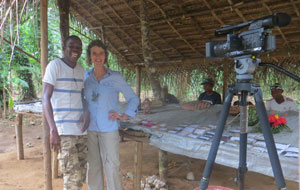

(With Nasim, the Spice Boy, in front of an array of local spices. The handmade labels are fabulous: “Cloves can be use for two sides, medicine and spices. It good for marking curry, pilau, cakes, tea and all dishes. Then it’s better for stopping Vomiting as a medicine.” And this: “Nutmeg. This is better for drinks, cooking and for woman that given up strong desire for making or to fulfil their men.”)
From spice haven to Stone Town, the historic port that was for centuries the focus of the slave trade. It’s here that a pair of shockingly small dungeons, each with two slits less than a hand span across for air flow were used to contain upwards of 70 people at a time. It’s estimated some 600,000 people died in these hell holes a year. The survivors of the crypts were traded at the infamous whipping tree, where those who withstood lashing without crying out fetched a higher sum than those who broke down. Stone Town is where one gets a real sense of the Island’s crossroads heritage, with Arabian architecture rubbing shoulders with African thatch, and signs featuring both Swahili and Arabic abounding. The doors of Zanzibar are rightly renowned, with their intricate fretwork and bold brass studs that have made them the subject of many a coffee table book. I visit the House of Wonders, a monumental pillared pile built by the Sultan of Zanzibar in the 1880s that was the first building in East Africa to have electricity and an elevator. The central courtyard houses a Swahili fishing boat – it really is a huge place!
From spice haven to Stone Town, the historic port that was for centuries the focus of the slave trade. It’s here that a pair of shockingly small dungeons, each with two slits less than a hand span across for air flow were used to contain upwards of 70 people at a time. It’s estimated some 600,000 people died in these hell holes a year. The survivors of the crypts were traded at the infamous whipping tree, where those who withstood lashing without crying out fetched a higher sum than those who broke down. Stone Town is where one gets a real sense of the Island’s crossroads heritage, with Arabian architecture rubbing shoulders with African thatch, and signs featuring both Swahili and Arabic abounding. The doors of Zanzibar are rightly renowned, with their intricate fretwork and bold brass studs that have made them the subject of many a coffee table book. I visit the House of Wonders, a monumental pillared pile built by the Sultan of Zanzibar in the 1880s that was the first building in East Africa to have electricity and an elevator. The central courtyard houses a Swahili fishing boat – it really is a huge place!
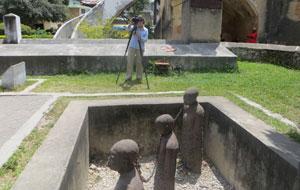
(Filming the monument to slavery at Stone Town. The crypts themselves were so dark and small that I failed to get a clear photograph.)
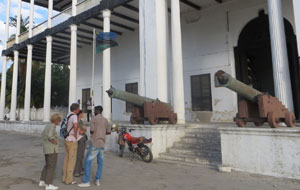
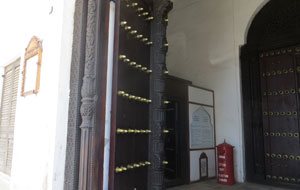
(The House of Wonders with its studded doors and remarkable cast iron pillars that allow it unusually high ceilings. It remains the largest building Zanzibar today.)
From the House of Wonders I lugged my gear down Zanzibar’s narrow alleys to Jafferji’s restaurant, possibly the Island’s most highly regarded guest house and eatery, and just a short walk from the home of Zanzibar’s celebrated son, Freddie Mercury. Jafferji’s courtyard was to be my cooking school for the next hour, with Chef Charles to guide me through the intricacies of coconut fish curry, bananas with cardamom, and Zanzibari pilau - a dish that is said to make your neighbours cry, such is its aroma! As for me, I was almost overwhelmed by the fragrance wafting up from the coal burners – the early flight had meant a quick coffee at the airport and a tiny sweet banana from a roadside stall as we made our way to the beach; now at 4 o’clock in the afternoon my tummy was rumbling so loudly I feared it would be picked up by the camera mic! I can report it was worth the wait – an absolutely delicious denouement to a pearler of a day.
The adventure isn’t over yet – it’s back to Dar es Salaam, where I hope to meet the President, before travelling south to a remote village where efforts are afoot to develop school exchanges with Australia.
From the House of Wonders I lugged my gear down Zanzibar’s narrow alleys to Jafferji’s restaurant, possibly the Island’s most highly regarded guest house and eatery, and just a short walk from the home of Zanzibar’s celebrated son, Freddie Mercury. Jafferji’s courtyard was to be my cooking school for the next hour, with Chef Charles to guide me through the intricacies of coconut fish curry, bananas with cardamom, and Zanzibari pilau - a dish that is said to make your neighbours cry, such is its aroma! As for me, I was almost overwhelmed by the fragrance wafting up from the coal burners – the early flight had meant a quick coffee at the airport and a tiny sweet banana from a roadside stall as we made our way to the beach; now at 4 o’clock in the afternoon my tummy was rumbling so loudly I feared it would be picked up by the camera mic! I can report it was worth the wait – an absolutely delicious denouement to a pearler of a day.
The adventure isn’t over yet – it’s back to Dar es Salaam, where I hope to meet the President, before travelling south to a remote village where efforts are afoot to develop school exchanges with Australia.
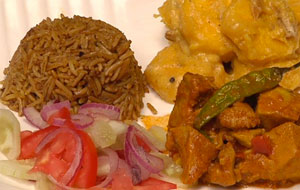
(Behold the feast! Naturally, local spices feature highly.
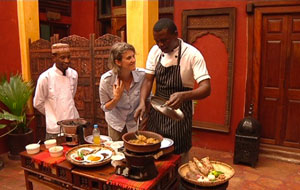
(Chef Charles stirs as I salivate! Clay pots and coal burners are common throughout Tanzania; even in those places with reasonably reliable electricity many cling to traditional cooking methods.)
Source: World News Australia







No comments :
Post a Comment